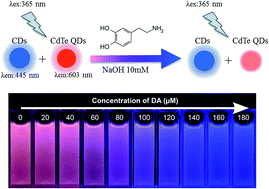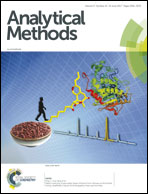Design of a ratiometric fluorescent probe for naked eye detection of dopamine†
Abstract
A simple and effective ratiometric fluorescence sensor for selective detection of dopamine (DA) in alkaline media has been developed by simply mixing thioglycolic acid (TGA) functionalized orange fluorescent cadmium telluride (CdTe) quantum dots (QDs) with amino-functionalized blue fluorescent carbon nanodots (CDs). Under a single excitation wavelength of 365 nm, the sensor exhibits dual-emissions centered at 445 and 603 nm. The fluorescence of CdTe QDs is selectively quenched by DA, whereas the fluorescence of CDs is insensitive to the analyte. In the presence of different amounts of DA, the variations in the dual emission intensity ratios exhibit a continuous color change from pink to purple and to blue, which can be clearly observed with the naked eye. The ratiometric fluorescent probe has been successfully applied for the detection of DA in water and urine with a detection limit of 1.3 μM. To facilitate their practical use, ratiometric fluorescent probe–agarose hydrogels were prepared as instrument-free and simple platforms for visual detection of DA.



 Please wait while we load your content...
Please wait while we load your content...